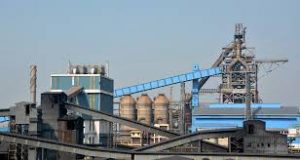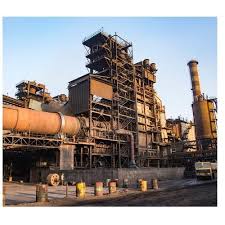 Dr. P. K. Jena in Bhubaneswar, September 28, 2019: Production of steel is the biggest metallurgical industry in the world. The steel in different forms is meeting the fast growing needs of human beings in various sectors. The major raw materials required for iron and steel production are iron ore, coal, limestone, water and energy. Most of the steel produced at present in the world are through Blast Furnace (BF) – Basic Oxygen Furnace (BOF). Iron ore, coke produced from coking coal and limestone are used as the raw materials to produce pig iron in the BF and the pig iron thus produced is further refined to produce steel mainly in BOF.
Dr. P. K. Jena in Bhubaneswar, September 28, 2019: Production of steel is the biggest metallurgical industry in the world. The steel in different forms is meeting the fast growing needs of human beings in various sectors. The major raw materials required for iron and steel production are iron ore, coal, limestone, water and energy. Most of the steel produced at present in the world are through Blast Furnace (BF) – Basic Oxygen Furnace (BOF). Iron ore, coke produced from coking coal and limestone are used as the raw materials to produce pig iron in the BF and the pig iron thus produced is further refined to produce steel mainly in BOF.
More than 800 BF are operating to produce nearly 65% of iron and the rest are produced by other methods. The reason is that, the BF is considered to be versatile in terms of operation, energy efficiency and quality of iron produced. However, the BF – BOF route for making steel involves high investment cost, long lead time and difficulties in producing suitable raw materials like coke from coking coal, high grade iron ore and limestone. Further, with increase in production of iron and steel, the coking coal reserve is being depleted very fast. The BF can only accept the coke obtained from coking coal because of its special properties.
Blast Furnace
Global steel production has reached 1808.6 million tons (MT) for the year 2018. Out of these China produced 928.3 MT and India produced only 106.5 MT during the same year. The World Steel Association (WSA) shows that, India is languishing at the bottom rung of the consumption ladder with a per capita consumption of only 70.9 Kg, whereas that for the global figure is 224.5 Kg.
In order to meet the increasing demand of steel with fast industrialization, India has to produce much more steel by utilizing the available resources. The most important bottle neck in this regard is the non availability of coking coal in the country to produce iron in BF. The coking coal reservein the country is much less than that required for iron making in the BF.
The total coal reserve of India is 315.148 billion tons of which primary coking coal is 5.313 billion tons, medium and semi coking coal are 29.219 billion tons and non-coking coal is 279.028 billion tons and Tertiary coal is 1.5888 billion tons. Out of the total reserves of coal in the country the coking coal is only 20% and the rest is low grade non-coking coal. This compels India to import a large quantity of coking coal to produce iron in BF by spending a huge amount of foreign exchange.
In view of this, it is necessary to produce iron which is the main raw material for the steel, by an alternate route, that is Direct Reduction Iron (DRI). The DRI is also popularly known as sponge iron because here unlike in BF, the iron is produced without melting in a porous form. In this case unlike in BF, the iron is formed in solid state from the iron ore lumps or pellets (formed out of iron ore fines) using hot reducing gases or non-coking coal. Both the processes are commercially available. In the gas based process, the reducing gas is produced by chemically reforming a mixture of natural gas (containing mostly methane) and flue gas from the reducing furnace in order to produce a mixture of hydrogen and carbon monoxide. Typical examples of the gas based processes include MIDREX and HYL. This method is preferred in countries where natural gas is abundant and cheap. In the coal based DR Process, the reducing gas is produced from non coking coal in the reduction zone of the furnace, typically a rotary kiln.

The typical examples of coal based process include SL / RN and ACCAR processes. Such coal based sponge iron making from iron ore, is popular both in India and China. However, in the world almost 80% of sponge iron is being produced by the gas based DR process. Both the gas and coal based DRI technology are gaining importance due to comparatively less investment cost, flexibility in using the raw materials like cheap iron ore fines, non-coking coal and natural gas. Generally, the scale of operation of gas based DRI is 0.82 – 1.2 MT per annum but coal based one is comparatively smaller (0.3 to 0.15 MT per annum).
As a matter fact, the sponge iron production in India was at a developmental stage during 1960s. It may be mentioned here that, in 1968 I guided a research programme on sponge iron making in low shaft furnace at Banaras Hindu University (BHU), sponsored by Government of India. According to the survey of Indian sponge iron industry prepared by Joint Plant Committee of Ministry of Steel, Govt. of India during 2005 – 2006, the gas based sponge iron units are mainly three in numbers belonging to Essar Steel, Vikram Ispat and Ispat Industries, all are in western region mainly due to proximity to natural gas sources. At that time, their report has shown that, the total number of coal based sponge iron units are 147 and the concentration of the units is maximum in Chhattisgarh (38) followed by Odisha (33) and West Bengal (30). The total capacity reported was about 11MT of sponge iron. It is reported that in 2009 the total production of sponge iron was 20.96 MT.
In India, most of the sponge iron producers do not have captive mines of any of the raw materials namely hematite, non-coking coal and limestone which are used for sponge iron production. Therefore, they fully depend upon other agencies to get their raw materials. Now the major constraints being faced by these industries are high price and non-availability of quality raw materials. The right grade hematite of proper size has become scarce and very costly. Most of the high grade non coking coal has been earmarked for thermal power plants and only inferior grades like ‘F’ and ‘G’ are available that too in a limited quantity. Most of the units are producing sponge iron much below their capacity mostly due to want of proper raw materials.
Due to availability of large amounts of high grade hematite and non-coking coal, the sponge iron industry has tremendous scope for further development. But, various problems being faced by the industries at present as mentioned above have made this industry sick. As during the years to come we need large amounts of steel, it is essential to promote both the non-coking coal and gas based sponge iron industries. These industries besides supplying enough sponge iron for steel production, can provide a lot of employment to skilled and semiskilled people in the country. In view of this, it is highly desirable to promote these industries by implementing the following programmes:
 (a) In view of non-availability of high grade lumpy iron ore as well as because of its high cost, it is appropriate to utilize the cheap and abundantly available low grade iron ore fines after suitable beneficiation and then agglomerating those as pellets. In this way, the cost of the major raw material the iron ore will be cheaper than the lumpy iron ore and also with better reducibility. This practice is being followed in many DRI units in the world as well as recently in India by some units. Those sponge iron units which are in small and medium sectors as per their need can develop the facilities for beneficiation of low grade ores and pelletizing those in a co-operative manner to make the units techno-economically viable.
(a) In view of non-availability of high grade lumpy iron ore as well as because of its high cost, it is appropriate to utilize the cheap and abundantly available low grade iron ore fines after suitable beneficiation and then agglomerating those as pellets. In this way, the cost of the major raw material the iron ore will be cheaper than the lumpy iron ore and also with better reducibility. This practice is being followed in many DRI units in the world as well as recently in India by some units. Those sponge iron units which are in small and medium sectors as per their need can develop the facilities for beneficiation of low grade ores and pelletizing those in a co-operative manner to make the units techno-economically viable.
(b) Similarly, the very low grade coal (F/G grade) can be upgraded to suit the requirement of the rotary kiln DRI units through washing and beneficiation. Again coal washing units can be setup in a cooperative manner by the concerned companies to meet their requirements. The technology is well known and already there are a number of washeries of non-coking coal in India to utilize the very low grade materials.
(c) All sponge iron units should have captive power plants to meet their energy requirements. As a lot of heat is lost in DRI units, Waste Heat Recovery Boiler (WHRB) captive power plants, with electrostatic precipitator should be installed. In such captive power plants, the waste coal fines and char fines of the concerned unit can also be utilized. This would be the best method of waste management.
(d) The water requirement of each of the DRI units can be met by harvesting rain water both on surface as well as recharging the aquifer, inside the plant premises or nearby areas. This would enable the sponge iron units to be independent of outside water sources. Further, they should recycle the used water in order to minimize the environmental pollution and maximize the conservation of water.
(e) By adopting various pollution control measures which are already available in the country for DRI units, the plant area can be kept pollution free. For example, it is possible to bring down the dust emission from about 12 tones to only 58 Kg per day of a 100 tons per day (TPD) kiln by adopting various air pollution controlled measures.
In this way by promoting the establishment of a large number of small and medium scale DRI units, it would be possible to extract good amounts of sponge iron from low grade iron ore and non-coking coal as well as natural gas to boost the production of steel. At the same time, the sponge iron units can employ a good number of skilled and semi-skilled persons. In this regard, both the central and concerned state governments have a significant role to play. They should take necessary steps to create a congenial atmosphere for promoting establishment of a large number of sponge iron plants to boost the production of steel in an environment friendly atmosphere.
(Former Director General, Council of Scientific & Industrial Research, India)


Leave a Reply
Be the First to Comment!